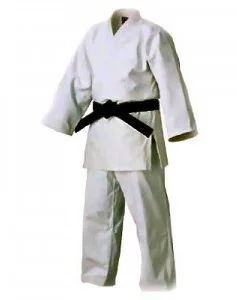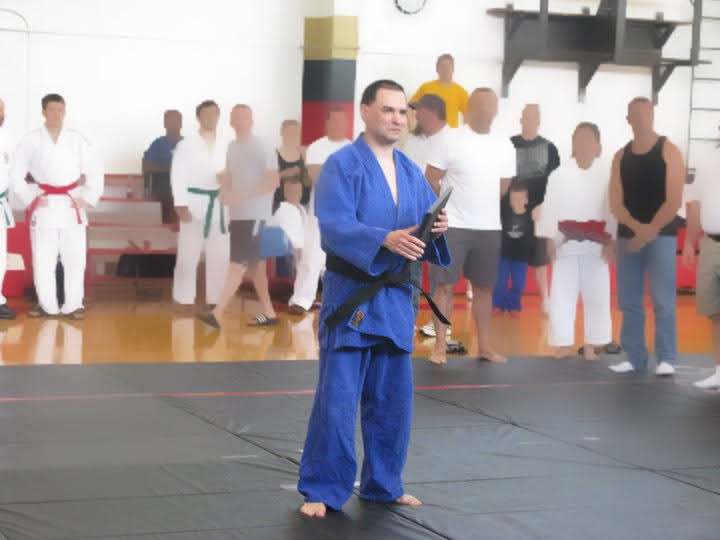
Also known as an “Empty Gi (or Empty Jacket)” style. Gi is pronounced with the “i” having a hard E sound, spoken: “Empty Gee”.
This is a Judo/Jujitsu Fighting Style based on principles of redirecting energy (not true non-resistance, but compared to other martial arts styles, more “relaxed” as well as, more reactive.
The concept of Empty-Gi-Aiki-Judo as discussed here, in the style of Judo, is comparable to the term Aiki used in martial arts such as Aikido, Hapkido and Aiki Jujitsu.
Therefore, we could also call it, Aiki Judo.
“Ai” (pronounced “eye”) can be interpreted as blending or merging. ”Ki” (pronounced “key”) can be translated as energy. ”Ju” can be translated as gentle. ”Do” (pronounced “doh”) can be translated as the way. This is the way of joining or combining with your practice partner or your opponent’s energy. Different martial arts do this by joining and then using a subsequent action of overtaking the opponent such as throwing, forcing submission, striking, etc., with the overall spirit of neutralizing the attack.
As it is presented here, the concept is utilized in a Judo based approach of omitting strikes and kicks. Judo is the martial art founded by Jigaro Kano in 1882. He had originally sought out instruction in Jujitsu because of bullying at his school. He had taken techniques of Jujitsu and modified them (omitting punches and kicks) and emphasized effective throws and submissions in order for a smaller person to be able to neutralize an attack from a larger person. Kano founded the Kodokan school in Japan, which became very reputable – so much so, that police began training in the art after a fight demonstration between students of the Kodokan against top Jujitsu athletes of Kano’s time.
Kano summarized the spirit of Judo with two guiding principles: 1) maximum efficiency with minimal effort, and 2) mutual welfare and benefit for all. Although Judo is “the gentle way” translated, it can be an aggressive sport. Some from other fighting backgrounds (wrestlers, those into mixed martial arts, and fighters whose training had emphasized power and strength), have entered Judo tournaments and have found success in Judo.
This particular approach of Aiki-Judo allows for those who are older, those who may not be in the best physical shape, and for those who may be seeking a more relaxed approach. This Empty-Gi-Aiki-Judo style is a fighting style that is very effective and equally as worthy of respect as “muscle power force” styles of martial arts.
Similarities
This fighting style of Judo is most similar to Daito-ryu Aiki-jujutsu as practiced by Takeda Sokaku. The concepts of redirecting an opponents energy, of using a pull when the opponent pushes, and adding to the force the opponent brings by redirecting to a throw, pin, joint submission, choke, or similar fashion of both neutralizing the attack and overcoming the opponent.
Welcome to the style of “empty gi”! Aiki Judo!
Aiki Empty Gi Style can extend outside the dojo as a way of life!
This style can be utilized for self defense, by the addition of strikes and other disabling means.
Empty Gi Aiki Judo style is not to be confused with retreating!
In order to use this style effectively, you have to be in close proximity, and I mean very close. Often people will confuse the Aiki Judo style with one of either passive resistance, or of behaving as though defenseless with overly defensive posturing, and/or confuse this style with being a style of retreating.
Aiki Judo is an active style of monitoring and using an opponent’s movement and balance to your advantage. In order to pull off a block, throw, and to provide redirection of the opponent’s energy and doing a counter, one must be extremely close in proximity to the opponent and additionally not moving away. Practically, the only time moving away would be an effective strategy is in the event that the opponent is pushing you away, where instead of using a stopping resistance, you go with the push (even adding to it by pulling) and then either redirect the energy by dropping into what is known as a sacrifice throw, or by using re-directive hand, hip, and leg movements to produce either a throw or submissive technique.

